1 Introduction to Art
This course is called “Introduction to Art”. It might better be called “Introduction to Visual Culture” because that is what we are all engaged with from the moment we wake up until the end of our day. When you turn on your television, open your phone or computer, or simply walk outside you have already accessed visually any number of aesthetic objects that someone – for our purposes we’ll call her an artist – made choices about in its presentation. From the packaging of your cereal to the design of your bicycle, the components and techniques artists use to make another visual medium we call “fine art” are tapped. For centuries makers have divided objects into utilitarian things and things with no other obvious use except to give us pleasure (there are exceptions – 18th century tapestries did keep out the castle drafts, but that’s a story for later). Today that dividing line has eroded, and even though we still have sections in museums for things like furniture, and museums for so-called crafts, the fact remains that these objects are also appreciated for their formal characteristics sufficiently that they are collected and placed in galleries, museums, and private collections. This class is intended to make you more visually sensitive to the world around you and to begin to understand your own aesthetic tastes and to seek out things that give you visual pleasure. (Another aside: “pleasure” is loosely used here; sometimes work we love makes us think, or even brings up unpleasant emotions, but we none-the-less appreciate them for their ability to touch us in some way.)
Human beings seem to be hard-wired to create. From sites of the earliest human – and even proto-human – occupation come objects that seem to be attempts to illustrate the world.
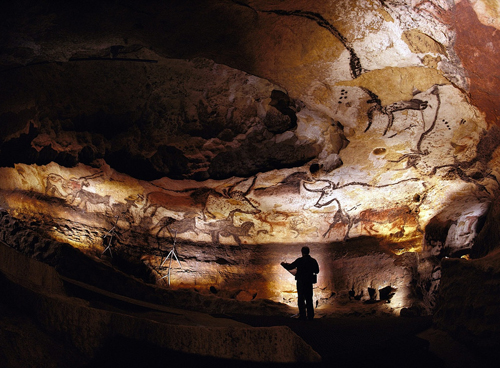
These images and objects have accompanied human beings throughout time. The forms, mediums, and techniques with which we have pictured our world has changed along with human beings, but their impulse to picture that world has not.
What is Art?
So how do we define “fine” art, then? Art is a highly diverse range of human activities which create visual, auditory, or performed artifacts— artworks—that express the author’s imaginative or technical skill, and are intended to be appreciated for their beauty or emotional power.
The oldest documented forms of art are visual arts, although archeologists suggest early humans also made music. Over time techniques – media – has included painting, sculpture, printmaking and, beginning in the 19th century, photography. Architecture is often included as one of the visual arts; however, like the decorative arts, it involves the creation of objects in which the practical considerations of use are essential in a way that they usually are not in another visual art like a painting. Art may be characterized in terms of mimesis (its “realistic” representation of reality), expression, communication of emotion, or other qualities. Though the definition of what constitutes art is disputed and has changed over time, general descriptions center on the idea of imaginative or technical skill stemming from human agency and creation. When it comes to visually identifying a work of art, there is no single set of values or aesthetic traits. A Baroque painting will not necessarily share much with a contemporary performance piece, but they are both considered art.
Despite the seemingly indefinable nature of art, there have always existed certain formal guidelines for its aesthetic judgment and analysis. Formalism is a concept in art theory in which an artwork’s artistic value is determined solely by its form, or how it is made. Formalism evaluates works on a purely visual level, considering medium and compositional elements as opposed to any reference to realism, context, or content. In this class you will learn to “read” an artwork according to its formal qualities – a “formal analysis”.
Art is often examined through the interaction of the principles and elements of art. The principles of art include movement, unity, harmony, variety, balance, contrast, proportion and pattern. The elements include texture, form, space, shape, color, value and line. The various interactions between the elements and principles of art help artists to organize sensorially pleasing works of art while also giving viewers a framework within which to analyze and discuss aesthetic ideas. In our next reading, we will learn more about the elements and principles of art and begin to use them to describe works of art.
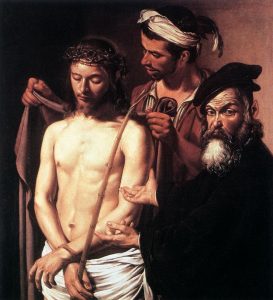
Caravaggio’s Ecce Homo is an example of a Baroque painting. It depicts the scene from the Bible in which Pontius Pilate displays Jesus Christ to the hostile crowd with the words, “Ecce homo!” (“Behold this man!”).
Bjork’s Mutual Core is an example of a contemporary performance piece. Video art is often an interdisciplinary mash-up of music, painting, performance, and other forms. Although very different in terms of medium, time period, and message, both of these works of art utilize similar elements and principles.
What Does Art Do?
A fundamental purpose common to most art forms is the underlying intention to appeal to – and connect with – human emotion. However, the term “art” is incredibly broad and can be broken up into numerous sub-categories that lead to utilitarian, decorative, therapeutic, communicative, and intellectual ends. In its broadest form, art may be considered an exploration of the human condition, or a product of human experience.
Artists create work that fulfills a number of emotional and sometimes practical uses in a culture. We often group these functions according to genre. [Genre refers in general to a classification of objects by form, content, or style. Specifically it refers to a category of works that use images of everyday life as subject matter.] Part of what artists do is to create work that is intended for a specific purpose.
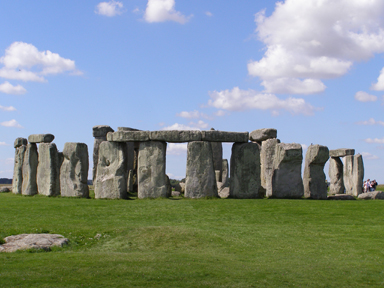
Stonehenge was created by Neolithic peoples for a purpose, even though today we cannot know conclusively what that purpose was. Archeologists assume it had a ritualistic purpose but may have also had meaning for those people that is lost to us today. Even so it continues to embody power for the thousands of modern people who visit it each year.
Artists also create versions of utilitarian objects that hold aesthetic value beyond the ordinary. The decorative arts add aesthetic and design values to everyday objects, such as a glass or a chair, transforming them from a mere utilitarian object to something aesthetically beautiful. Entire schools of thought exist based on the concepts of design theory intended for the objects in the physical world.

This computer graphic of the famous chair designed by Marcel Breuer in 1925 has become an icon of what we call “modernism.”
We are familiar with art that provides a record of actual historical events. Artists from cultures all over the world have created visual documentation of moments that held particular significance for the society at the time. In the 17th century, the French Academy called this genre of painting “history painting” and afforded it the highest place in its hierarchy of genres.
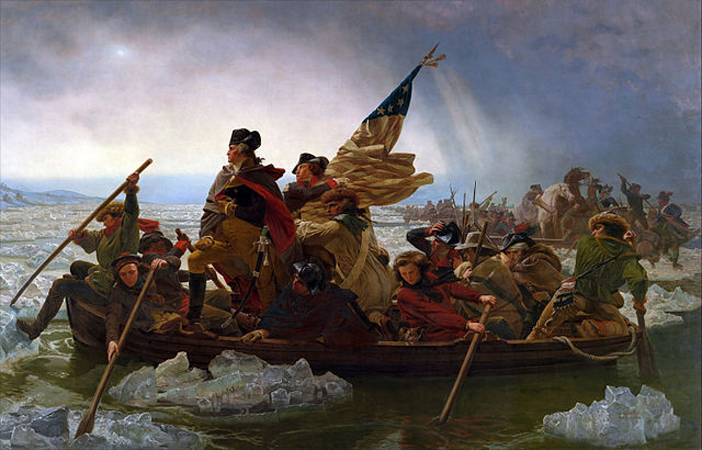
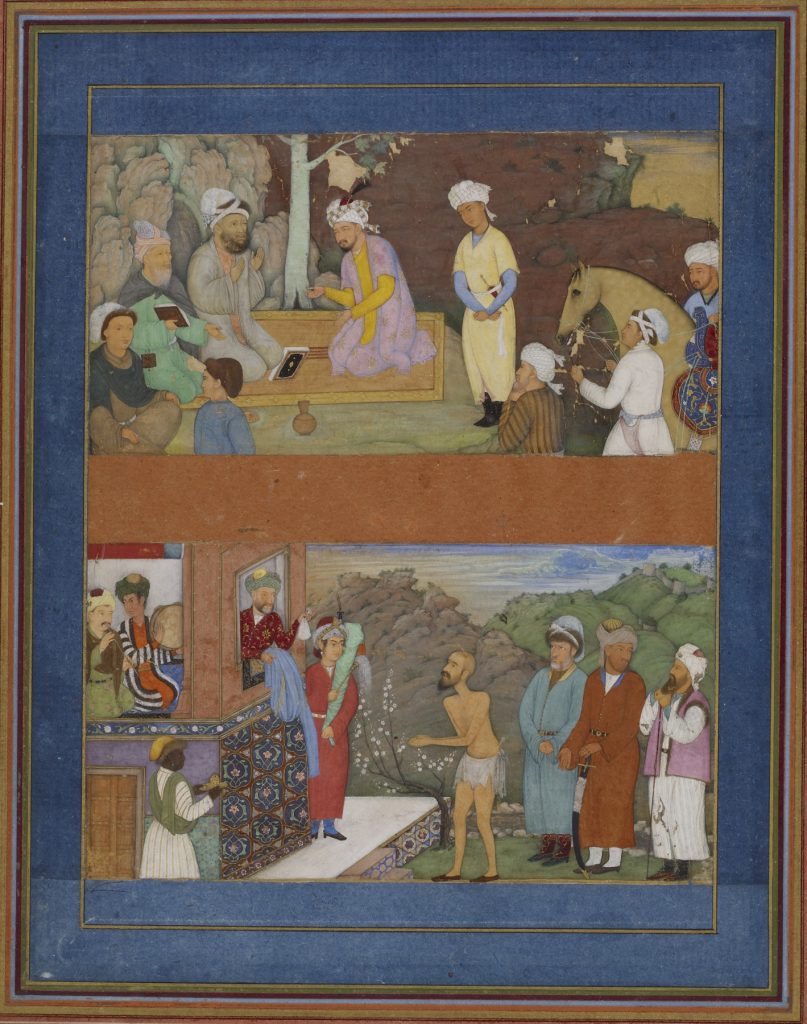
Washington Crossing the Delaware is a subject from American history that has been represented by a number of artists over the years. The two Islamic illustrations above are from a Mughal Dynasty manuscript; the opening chapter is entitled “The Conduct of Kings”; the upper register (horizontal band of images) depicts a prince visiting holy men in the wilderness. The lower illustrates a parable about a king who had given a large sum of money to a beggar. The beggar spends the king’s large gift and then returns for more. When the king refuses his minister advises him to gift the beggar money in regular small amounts instead, the moral being that one should not give hope by an act of unbounded kindness that you are not willing to continue.
Art can also illustrate beliefs that are deeply held but cannot be seen – this kind of art is best seen in various religious traditions.
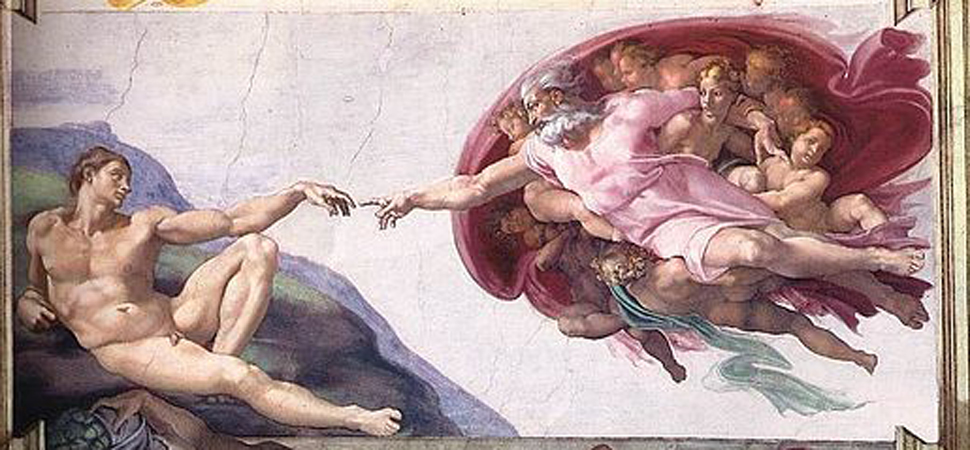
Some religions require images of their gods while others prohibit such images. The Catholic church has a rich tradition over centuries of picturing the many stories and personages of that practice; however, the Christian offshoot of Protestantism did not choose to picture those deities and worshiped in churches virtually without representational ornamentation.
The need to give physical form to the gods has been a common impulse in human beings across time and many very different cultures, however.
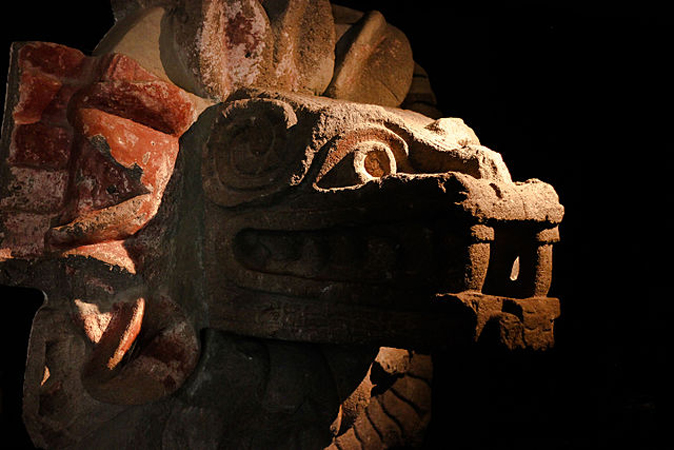
This large head represents the god Quetzalcoatl from the Museum of Anthropology in Teotihuacan. (Isaact92.) Quetzalcoatl was the Plumed Serpent god of several cultures in MesoAmerica.
One of the most universal functions of art is to help us externalize human emotions or visualize the human condition in general. Various artists throughout art history have expressed their own emotions and allowed viewers to empathize. One of the most famous paintings which suggests the internal state of the artist who painted it is Van Gogh’s Wheat Field with Crows from 1890.
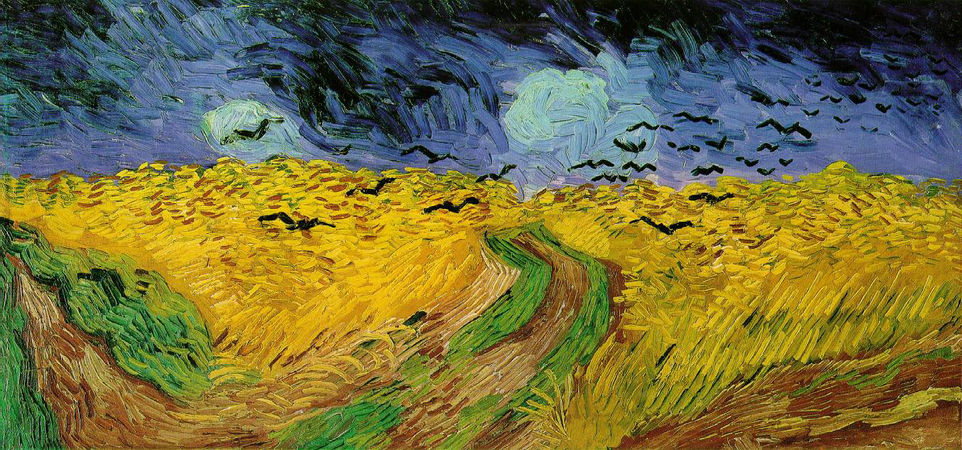
Van Gogh had long suffered from debilitating bouts of mental and physical illness. He painted this work near the end of his life. The lowering, stormy skies along with the apparent dead-end path and black, ominous cloud of crows was intended, according to Van Gogh, to suggest “sadness, extreme loneliness”, but also to show what he believed was “healthy and fortifying about the countryside.” (http://vangoghletters.org/vg/letters/let898/letter.html. To Theo van Gogh and Jo van Gogh-Bonger. Auvers-sur-Oise, on or about Thursday, 10 July 1890.)
Art can function therapeutically as well, an idea that is imployed in art therapy. While definitions and practices vary, art therapy is generally understood as a form of therapy that uses art media as its primary mode of communication. It is a relatively young discipline, first introduced around the mid-20th century. Individuals who have difficulty expressing their internal state verbally can sometimes, it is thought, represent those feelings in visual form more easily.
Historically, the fine arts were meant to appeal to the human intellect as well as to the emotions, though currently there are no true boundaries. Typically, fine art movements have reacted to each other both intellectually and aesthetically throughout the ages. With the introduction of conceptual art and postmodern theory, practically anything can be termed art. In general terms, the fine arts represent an exploration of the human condition and the attempt to experience a deeper understanding of life and the world both around and within us.
To this end, art can make us more aware of the ordinary – the world as we experience it every day. Artists create moments which pull us out of ourselves and out of our daily lives and make us notice and think about the world in new ways. Graffiti art like that of Banksy can create those moments for us. He is so popular because he creates unexpected moments of visual expression for us.

Meaning in Art
In many ways, this is the most problematic issue we will address in this class. Often when we are confronted with something that is unusual, extreme, and unexpected we don’t know how to respond to it. It may make us uncomfortable; we might feel like the person who made it is trying to make us feel stupid because we don’t understand what we’re seeing or why others think it’s important. We might think that the artist is trying to fool us into taking seriously something with no value. While this is a natural response it cuts us off from the richness of art by making us focus on “meaning” to the exclusion of all else. I would ask you, as we begin to think about these things, to put that aside for now. When you are inclined to dismiss a work step back and see if you can find something in it to appreciate – maybe just to question. You’ll find that sometimes art is just about art – meta-art. It may not “mean” anything, or at least not in any way that is accessible to us. But if we give it a chance we might be able to appreciate things in it like color or shape or line, or something that isn’t really meant to challenge us intellectually but rather optically. All art communicates, or at least all good art does. What it communicates and how may often depend as much on the viewer as it does the artist’s original intention.
The meaning of art is often culturally specific, shared among the members of a given society and dependent upon cultural context. The purpose of works of art may be to communicate political, spiritual or philosophical ideas, to create a sense of beauty (see aesthetics), to explore the nature of perception, for pleasure, or to generate strong emotions. Its purpose may also be seemingly nonexistent.
Art, in its broadest sense, is a form of communication. Philosophers have grappled with the meaning of art in human culture for ages. Essentially, a work of art means whatever the artist intends it to mean, and this meaning is shaped by the materials, techniques, and forms it makes use of, as well as the ideas and feelings it creates in its viewers. Art is an act of expressing feelings, thoughts, and observations.
Beauty in Art
What makes art beautiful is a complicated concept, since beauty is subjective and can change based on context. However, there is a basic human instinct, or internal appreciation, for harmony, balance, and rhythm which can be defined as beauty. Beauty in terms of art usually refers to an interaction between line, color, texture, sound, shape, motion, and size that is pleasing to the senses.
Aesthetic Art
Aesthetics is the branch of philosophy that deals with the nature and appreciation of art, beauty, and taste. Aesthetics is central to any exploration of art. The word “aesthetic” is derived from the Greek “aisthetikos,” meaning “esthetic, sensitive, or sentient. ” In practice, aesthetic judgment refers to the sensory contemplation or appreciation of an object (not necessarily a work of art), while artistic judgment refers to the recognition, appreciation, or criticism of a work of art.
Numerous philosophers have attempted to tackle the concept of beauty and art. For Immanuel Kant, the aesthetic experience of beauty is a judgment of a subjective, but common, human truth. He argued that all people should agree that a rose is beautiful if it indeed is. There are many common conceptions of beauty; for example, Michelangelo’s paintings in the Sistine Chapel are widely recognized as beautiful works of art. However, Kant believes beauty cannot be reduced to any basic set of characteristics or features.
For Arthur Schopenhauer, aesthetic contemplation of beauty is the freest and most pure that intellect can be. He believes that only in terms of aesthetics do we contemplate perfection of form without any kind of worldly agenda – an intellectual or personal remove with no end besides the enjoyment of contemplation.
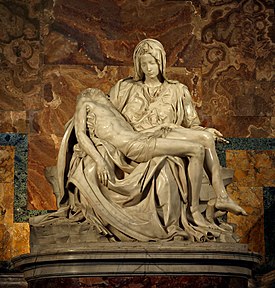
Beauty in art can be difficult to put into words due to a seeming lack of accurate language. An aesthetic judgment cannot be an empirical judgment but must instead be processed on a more intuitive level. In 1964, Supreme Court Justice Potter Stewart wrote that he couldn’t adequately define “pornography” but that he knew it when he saw it. (378 U.S. 184, 1964) Weirdly, this is true of art as well. It is visually satisfying, or stimulating, for reasons that we often find hard to quantify or describe.
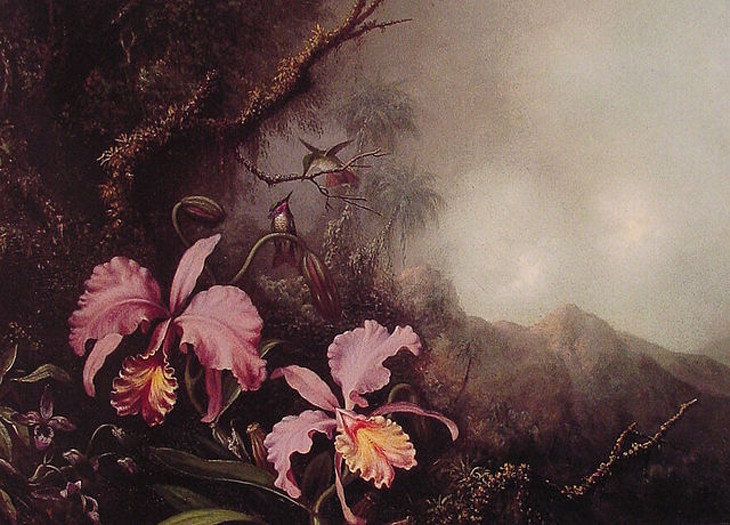
Art and Human Emotion
Sometimes beauty is not the artist’s ultimate goal. Art is often intended to appeal to, and connect with, human emotion. Artists may express something so that their audience is stimulated in some way—creating feelings, religious faith, curiosity, interest, identification with a group, memories, thoughts, or creativity. For example, performance art often does not aim to please the audience but instead evokes feelings, reactions, conversations, or questions from the viewer. In these cases, aesthetics may be an irrelevant measure of “beautiful” art.
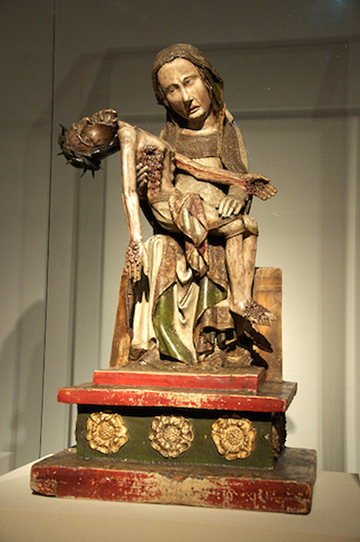
The Röttgen Pietà is an example of an object that in some cultures was created to be typically “beautiful” with graceful figures and soft, curving lines. In Northern Europe, however, the pietà [an image of the Virgin holding the dead Christ on her lap] was created to fulfill other purposes. In the North the Christian figures and icons were created to appeal directly to the emotions of the viewers. Rather than provide a satisfying aesthetic reminder these images were intended to suggest that human pain and suffering was shared between humanity and their God.
Who is an “Artist”?
An artist is a person who is involved in the wide range of activities that are related to creating art. The word has transformed over time and context, but the modern understanding of the term denotes that, ultimately, an artist is anyone who calls him/herself an artist.
In ancient Greece and Rome, there was no word for “artist.” The Greek word “techne” is the closest that exists to “art” and means “mastery of any art or craft.” From the Latin “tecnicus” derives the English words “technique,” “technology,” and “technical.” From these words we can denote the ancient standard of equating art with manual labor or craft.
Each of the nine muses of ancient Greece oversaw a different field of human creation. The creation of poetry and music was considered to be divinely inspired and was therefore held in high esteem. However, there was no muse identified with the painting and sculpture; ancient Greek culture held these art forms in low social regard, considering work of this sort to be more along the lines of manual labor. During the Middle Ages, the word “artista” referred to something resembling “craftsman,” or student of the arts. The first division into “major” and “minor” arts dates back to the 1400s with the work of Leon Battista Alberti, which focused on the importance of the intellectual skills of the artist rather than the manual skills of a craftsman. The European academies of the 16th century formally solidified the gap between the fine and the applied arts, which exists in varying degrees to this day. Generally speaking, the applied arts apply design and aesthetics to objects of everyday use, while the fine arts serve as intellectual stimulation.
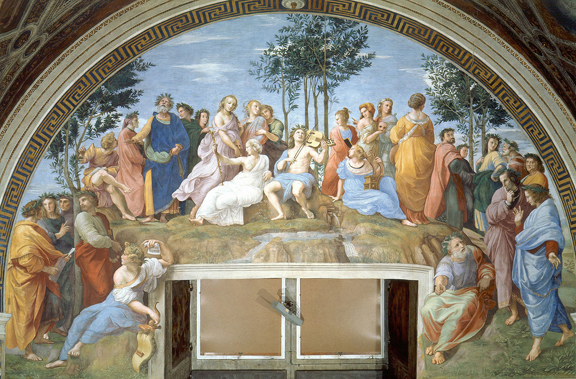
Currently, the term “artist” typically refers to anyone who is engaged in an activity that is deemed to be an art form. However, the questions of what is art and who is an artist are not easily answered. The idea of defining art today is far more difficult than it has ever been. After the exhibition during the Pop Art movement of Andy Warhol’s Brillo Box and Campbell’s Soup Cans, the questions of “what is art?” and “who is an artist?” entered a more conceptual realm. Anything can, in fact, be art, and the term remains constantly evolving.
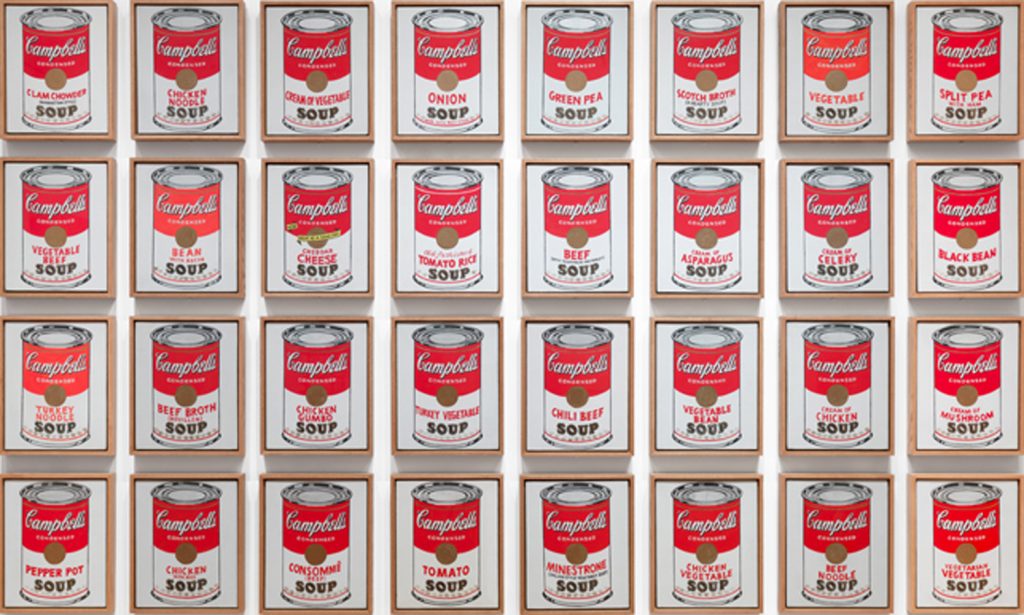
Andy Warhol’s Campbell’s Soup Cans have come to be representative of the Pop Art movement.
One group of makers who never intended their work for public consumption have become increasingly noticed and celebrated in recent years.
https://www.justfolk.com/product/black-dog-running/
Bill Traylor was born in slavery in Alabama in 1854. After emancipation, he continued to work as a sharecropper. In 1935, in his early 80s, Traylor moved into the city of Montgomery and began to make images that recalled his life on the farm. Traylor never intended his work as “art” in the way we think of it. When he was discovered in the 80s his work quickly became popular and now sells for thousands of dollars at auction. Artists like Traylor are called “naïve”, “folk”, or “Outsider” artists because they made work outside the mainstream and had no formal training as an artist. Other well-known artists like this are Henry Darger, Grandma Moses, James Hampton, and Maud Lewis.
Representation
There are art historical terms to describe certain visual conventions that have grown up over time. Many of these are seen in earlier periods, but contemporary artists still use versions of these conventions because the ideas they embody are universal. One of these terms is vanitas, from the Latin vanus, meaning empty or valueless, and is also the term from which we get the word “vanity”.
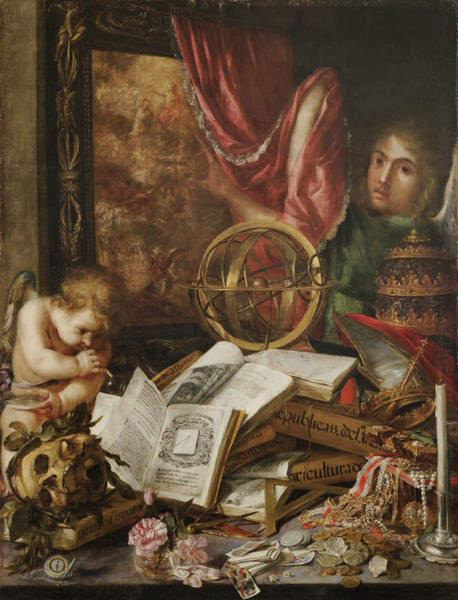
Valdés Leal, a Spanish Baroque painter, employed images to make up this Vanitas painting [a type of painting meant to bring to mind the shortness of life and the worthlessness of worldly things in the face of eternity]; art historians employ something called iconography [the identification and meaning of subject matter in art] to help understand the meaning of images in art. All Vanitas paintings use similar objects, although there are regional differences. A human skull is a pretty good indication that you’re looking at a Vanitas painting, but Dutch Baroque vanitas painting doesn’t always include a skull. Other objects like fruit and flowers (they die and rot, like human bodies), candles and calendars (they bring to mind the idea of time passing), and jewels, money, and often medals or military honors (things which have no value after death) are all typical objects in a Vanitas painting. Iconography is the one tool art historians use which requires study and a familiarity with historical context. This is difficult for a new student to employ but it should suggest that historical meanings are often not those we might attach to objects today.

Audrey Flack used those historical ideas in the 1970s to paint images that were intended to remind us of the same things, but she also used images that had a feminist context. Another typical Vanitas image was that of a young woman looking in a mirror, sometimes with a skull sitting near her or even with Death looking over her shoulder. These Death and the Maiden images conflated women and vanity, a cliché about women that Flack was also drawing attention to.
Representation, Abstraction, and Nonrepresentation
We describe art in a number of ways that refer to the manner in which it is pictured, or its style. Style has broader meaning, but here are a few examples and definitions of the main ways imagery is categorized. You will want to pay special attention to these categories as you will be asked to recognize them in works of art.
Representational Art
This kind of art seeks to recreate our actual visual experience of the world. We might way it looks “real” or “realistic.” Representational is better because it includes the idea that art is art – not the actual object and is the product of the artist’s hand and eye even though we have no problem recognizing the image.
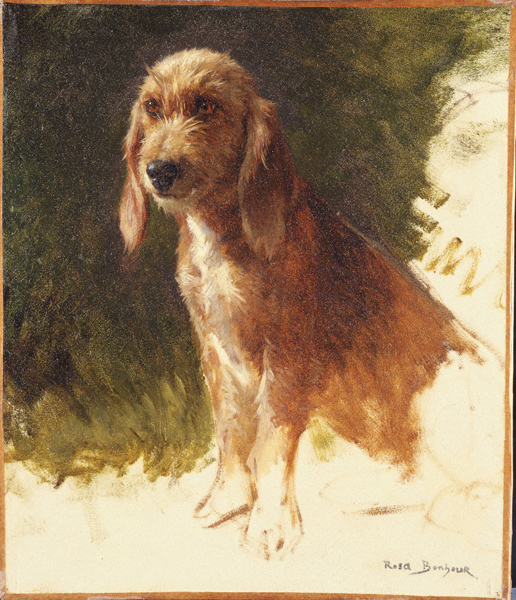
“Bonheur was renowned for her animal paintings. She may have seen the long-eared terrier that is the subject of this oil study in the Fontainebleau forest, near her home in Thomery, or it may have been one of the many pets she kept throughout her life. Bonheur’s work is characterized by direct observation and careful draftsmanship. Traditional in her approach, she produced numerous preparatory sketches, like this one, before creating a painting. In 1865, Bonheur became the first woman awarded the Grand Cross of the Legion of Honor, a coveted honor established by Napoleon.”
We understand that this is a picture of a dog even though the bottom is unfinished.
Abstract
When we describe an image as “abstract” we mean that it has its roots in the observed world but the artist has exaggerated certain visual elements. We know what it is but it doesn’t look the way we would actually expect that object to look in the real world.
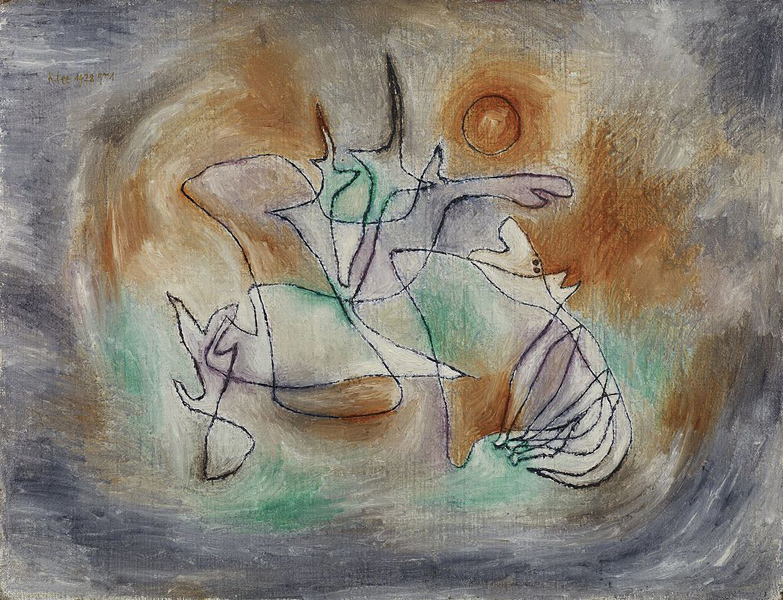
Paul Klee (1879 – 1940) was a Swiss-German artist whose work
Paul Klee (1879 – 1940) was a Swiss-German artist whose work was highly influenced by children’s drawings and other non-traditional sources. He wrote about art and taught at the Bauhaus school of art, design and architecture. Here Klee gives us a dog howling at the moon and a suggestion of the howl itself. This would be described as “abstract” because the subject is one we can recognize but painted in a way that exaggerates forms, colors, and its environment.
One aspect of the word “abstract” that you may find confusing is its use in other contexts. The word has come to mean things that might better be described as “non-representational” rather than abstract, but even the Abstract Expressionist movement which contained work that primarily had no literal visual correspondent in the natural world was given that title. Possibly the Nonrepresentational Expressionists was too long and clumsy.
Nonrepresentation
This one is pretty straightforward. Art that doesn’t have subject matter that seems to recreate an object from the observable world is called “nonrepresentational”.
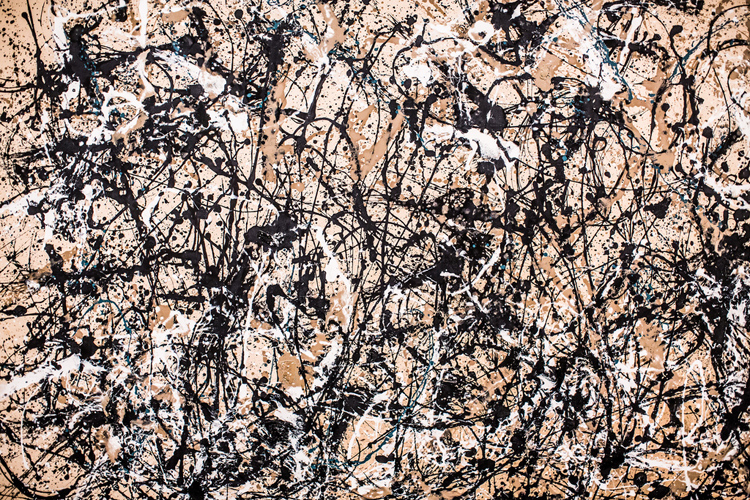
The only thing representational about Pollock’s work is the title, but nothing in the painting itself suggests the season. It is rhythmic in the swoop and flow of brushwork, or drips, but it remains essentially a painting that is only about its formal qualities. We can appreciate the feeling of action (some Abstract Expressionist painters like Pollock were also called “Action Painters” because of the broad gestural brushwork) and the colors and the depth we feel because of the overlapping paint, but it doesn’t represent anything literal. You may find the word “nonobjective” also employed for this kind of work, but for our purposes nonrepresentational seems more appropriate.
Form and Content
Form is used to describe the way a work of art looks. In the next section we will learn terms that help describe the form of art. Content is what the work is about. In other words, Rosa Bonheur’s study of a dog was “about” a dog – that was its content. Pollock’s Autumn Rhythm #30 also has content, but as we’ve seen the content can best be described in formal terms. The form is the content. Often the medium used in a work of art does give it meaning, or content, that it wouldn’t have in another medium. Andy Goldsworthy is a Scottish artist who works with natural elements like leaves and sticks and stones to draw attention to the environment. You can see examples of his work here:
The context in which we encounter an object can also affect its meaning. Modern photographs of, for example, a religious object may have a purely aesthetic interest for us while if we came across it in a cathedral we might understand it differently.
The Objects of Art
Especially in the twentieth century artists began to question the value of the art object itself. Marcel Duchamp questioned the exclusivity of art-making when he appropriated everyday objects like bicycle wheels, bottle racks and urinals in his readymades. This relationship of art and object became even more problematic with movements like the Happenings of the 60s, or the Fluxus artists’ performances, or finally Conceptual art in which the idea is often art enough. Another way objects have been made less precious but remained in a gallery or museum setting is installation art. Art can inhabit an entire space, indoor or out, and the viewer experiences the work with their entire body.
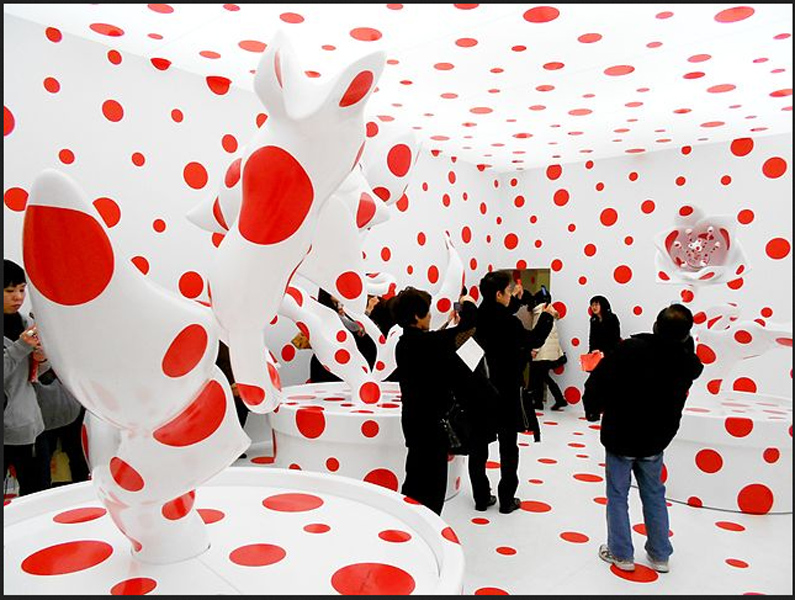
This basic introduction to some of the ideas we encounter when we begin to think about art is only a jumping-off-place for us. In the sections to come we will flesh out these ideas with examples and descriptions of various kinds, techniques, and methods of art-making, and finally we’ll take a brief historical tour through art through the ages in the West.
Licenses and Attributions: https://courses.lumenlearning.com/boundless-arthistory/chapter/what-is-art/

